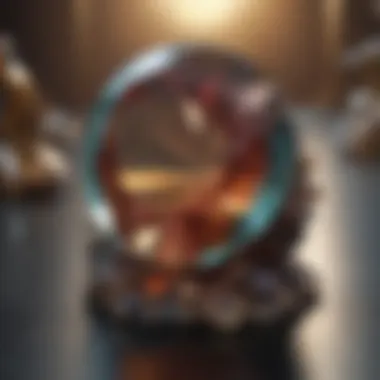Precision Craftsmanship: The Art of Gemstone Cutting and Polishing Machinery


Gemstone Cutting and Polishing: Unveiling the Precision Behind a Masterpiece
This article delves into the intricate world of gemstone cutting and polishing machines, uncovering the meticulous process and advanced technology involved in crafting exquisite gemstones. From the initial shaping to the final polishing, every step plays a crucial role in transforming raw gemstones into dazzling works of art.
Rock and Fossil Identification
Gemstones are classified by a variety of criteria such as color, hardness, transparency, and more. The identification of gemstones involves looking at their physical properties, crystal structure, and growth patterns. Certain tools like refractometers and microscopes aid in assessing gemstone characteristics.
Collecting Tips and Techniques
For aspiring gem enthusiasts, understanding the best practices for collecting gemstones is essential. Knowing how to identify prime collection sites and safely extract specimens ensures a successful and rewarding collecting experience. Utilizing tools like chisels and brushes helps in the careful extraction of gems.
Preservation and Display
Preserving gemstones requires strategic techniques to maintain their luster and integrity over time. Proper storage is vital to prevent gemstone tarnishing and damage. Creative display ideas, such as using lighted cases and rotating platforms, enhance the beauty of your gemstone collection.
Geological Insights
Delve into the geological insights surrounding gemstones, including their formation processes and the historical significance of certain gemstone varieties. Learn about notable discoveries in the field of gemology and the impact they've had on the industry and our understanding of Earth's geological history.
Introduction to Gemstone Cutting and Polishing
In the realm of gemstone cutting and polishing, precision is the cornerstone of transforming raw gemstones into breathtaking masterpieces. This section serves as a gateway into the intricate world where every facet plays a crucial role in crafting exquisite gemstones. By delving into the processes involved in shaping and polishing gemstones, readers will gain a deep appreciation for the meticulous artistry and advanced technology that underpins the creation of these dazzling works of art.
Understanding the Art of Gemstone Cutting
History of Gemstone Cutting Techniques
The history of gemstone cutting techniques unfolds like a tapestry of ancient craftsmanship meeting modern innovation. Dive into the evolution of cutting methods, from the rudimentary tools of the past to the state-of-the-art technology shaping gemstones today. Explore the significance of historical techniques in laying the foundation for present practices, shedding light on the intricate skills passed down through generations. By understanding the history of gemstone cutting, readers will grasp the rich heritage that continues to influence the precision and artistry seen in gemstone craftsmanship today.
Significance of Precision and Expertise


In the world of gemstone cutting, precision and expertise reign supreme, setting the standard for excellence in the industry. Unravel the intricate techniques and intricate processes that gem cutters employ to achieve impeccable results. Discover the paramount importance of precision in enhancing the beauty and value of gemstones, showcasing the culmination of skill, knowledge, and dedication required in every cut. By exploring the significance of precision and expertise, readers will appreciate the fine balance between technical proficiency and creative artistry that defines the art of gemstone cutting.
Evolution of Gemstone Polishing
Traditional Polishing Methods
Traditional polishing methods embody the essence of time-honored craftsmanship, where hand skills and attention to detail converge to bring out the luster and brilliance of gemstones. Examine the techniques passed down through the ages, highlighting the artistry and finesse of artisans who honed their craft through centuries of practice. Dive into the nuances of traditional polishing, understanding how these methods form the foundation for modern polishing practices and continue to hold a special place in the hearts of gemstone connoisseurs.
Modern Innovations in Polishing Technology
The landscape of gemstone polishing has been revolutionized by modern innovations, introducing cutting-edge technology that enhances efficiency and precision. Explore the avant-garde techniques and machinery that have elevated gemstone polishing to new heights, offering optimal control and quality in the final stages of gem refinement. Delve into the advantages of modern polishing technology, from time-saving automation to consistent results, reshaping the industry's standards and pushing the boundaries of what is achievable in gemstone perfection.
Key Components of Gemstone Cutting Machine
In the realm of gemstone cutting and polishing, understanding the key components of a cutting machine is paramount to achieving precision and excellence in the final product. The components of a gemstone cutting machine, such as Blades and Cutting Discs, form the backbone of the entire process. Blades carry out the intricate task of cutting through gemstones with utmost accuracy, ensuring that the desired shape and size are achieved flawlessly. The cutting discs play a crucial role in facilitating the cutting process, ensuring smooth and precise cuts are made without compromising the integrity of the gemstone.
When delving into the specifics of blades utilized in gemstone cutting machines, Diamond-tipped Blades stand out as a pinnacle of cutting technology innovation. These blades are embedded with industrial-grade diamonds on their edges, allowing for unparalleled strength and cutting precision. The remarkable hardness of diamonds enables the blades to cut through even the toughest gemstone materials with ease, providing a clean and sharp finish to the cut surfaces. The use of Diamond-tipped Blades not only ensures accuracy in cutting but also significantly reduces the risk of chipping or damaging the gemstone during the cutting process.
On the other hand, the Role of Water Cooling Systems in gemstone cutting machines serves a vital function in maintaining optimal operating temperatures during the cutting process. Water cooling systems help dissipate heat generated by the cutting blades, preventing overheating and potential damage to the gemstone being processed. By constantly circulating and cooling the blades and gemstone, water cooling systems increase cutting efficiency and accuracy while extending the lifespan of the cutting tools.
Moving on to Laser Cutting Technology, this advanced technique revolutionizes the precision and efficiency of gemstone cutting processes. The Precision Laser Cutting Process involves the utilization of focused laser beams to make intricate cuts and designs on gemstones with micron-level accuracy. This technology allows for the creation of complex shapes and patterns that were previously challenging to achieve using traditional cutting methods. The precise nature of laser cutting minimizes material wastage and ensures consistent cutting results across various gemstone types.
Furthermore, the Advantages of Laser Cutting in the gemstone industry are manifold. Laser cutting offers unparalleled control over the cutting process, enabling gem cutters to achieve immaculate cuts with minimal material loss. The non-contact nature of laser cutting eliminates the risk of physical damage to fragile gemstones, making it a preferred choice for working with delicate or valuable stones. Additionally, laser cutting allows for rapid production of accurately cut gemstones, enhancing efficiency and productivity in gemstone processing facilities.
In essence, the key components of a gemstone cutting machine, including Diamond-tipped Blades, Water Cooling Systems, and Laser Cutting Technology, play essential roles in shaping raw gemstones into exquisite works of art. These components embody precision, innovation, and efficiency, driving the gemstone industry towards advancements in gem cutting and polishing techniques.
Advanced Features of Gemstone Polishing Machine
In the realm of gemstone cutting and polishing, the role of advanced features in polishing machines cannot be overstated. These sophisticated capabilities elevate the art of gemstone processing to new heights, ensuring precision and quality that are paramount in creating captivating gemstone masterpieces. Advanced features encompass a wide array of technological innovations that enhance the polishing process, resulting in refined finishes and enhanced gemstone aesthetics. The integration of these cutting-edge elements is crucial to achieving impeccable results that meet the high standards of both artisans and collectors alike. By delving into the advanced features of gemstone polishing machines, we gain insights into the intricacies of gemstone craftsmanship and the tools that enable artisans to unleash the full potential of these precious stones.
Rotary Polishing Drums


Functionality and Benefits
The fundamental functionality of rotary polishing drums lies in their ability to facilitate the polishing phase of gemstone processing effectively. These drums are designed to rotate smoothly, allowing gemstones to interact with polishing agents uniformly, resulting in consistent and polished surfaces. The benefits of using rotary polishing drums are multifold, from enhancing the luster of gemstones to creating smooth textures that elevate the overall visual appeal of the stones. One key characteristic of rotary polishing drums is their versatile nature, enabling them to accommodate various gemstone shapes and sizes with precision. Moreover, the controlled rotation of these drums ensures that each gemstone receives uniform polishing, eliminating inconsistencies and imperfections. The unique feature of rotary polishing drums lies in their efficiency and ability to streamline the polishing process, ultimately saving time and resources while maintaining high-quality standards.
Types of Polishing Drums
When exploring the world of gemstone polishing machines, understanding the different types of polishing drums is vital to selecting the most suitable tool for specific polishing needs. Various types of polishing drums, such as barrel drums and vibratory drums, offer distinct advantages in terms of polishing efficiency and output quality. Barrel drums are known for their gentle yet thorough polishing action, making them ideal for delicate gemstones that require a subtle touch. On the other hand, vibratory drums excel in achieving high-gloss finishes on a wide range of gemstone materials, thanks to their rapid movement and abrasive media. The key characteristic of different polishing drums lies in their unique mechanisms that cater to specific polishing requirements, whether it be imparting a matte finish or enhancing the brilliance of faceted stones. Understanding the advantages and disadvantages of each type of polishing drum is essential for gemstone artisans seeking to achieve desired results that align with their craftsmanship goals.
Automated Polishing Systems
Robotics Integration
The integration of robotics in automated polishing systems revolutionizes the gemstone processing industry by introducing unparalleled precision and efficiency to the polishing process. Robotics integration optimizes the workflow of gemstone polishing, allowing for consistent and machine-controlled movements that surpass traditional manual techniques. The key characteristic of robotics integration is its ability to execute intricate polishing patterns with absolute accuracy, enhancing the overall quality and uniformity of gemstone finishes. This innovative feature not only reduces human error but also increases productivity by automating repetitive tasks, allowing artisans to focus on creative aspects of gemstone design and customization. The advantages of robotics integration in gemstone polishing machines extend to enhanced productivity, minimized wastage, and consistency in polishing results, making it a popular choice for artisanal workshops and industrial-scale gemstone processing facilities.
Precision Control Mechanisms
Precise control mechanisms are at the core of automated polishing systems, ensuring that gemstones undergo accurate and uniform polishing throughout the processing cycle. These control mechanisms dictate crucial variables such as rotational speed, pressure, and abrasive media distribution, crucial in determining the final finish of gemstones. The key characteristic of precision control mechanisms lies in their ability to fine-tune polishing parameters to meet specific design requirements, resulting in tailored polishing outcomes for each gemstone. Artisans benefit from the flexibility offered by precision control mechanisms, allowing them to adjust polishing settings according to gemstone hardness, size, and desired polish finish. The unique feature of precision control mechanisms is their adaptability and precision, enabling artisans to achieve consistent and high-quality results with optimal efficiency and minimal material wastage.
Innovative Techniques in Gemstone Cutting and Polishing
In the realm of gemstone cutting and polishing, the utilization of innovative techniques holds immense significance. These techniques represent a paradigm shift in the approach to crafting exquisite gemstones. By integrating cutting-edge technologies, artisans can elevate the precision and quality of their creations to unparalleled heights. The innovative techniques explored in this article revolutionize traditional methods, offering unique benefits and considerations that redefine the art of gemstone cutting and polishing.
One key element of innovative techniques in gem cutting and polishing is the incorporation of Computer-Aided Design (CAD) systems. This revolutionary approach integrates virtual prototyping of gemstone shapes, allowing artisans to visualize and manipulate designs with unprecedented accuracy and detail. The implementation of CAD software enhances efficiency and streamlines the production process, ensuring optimal precision in converting raw gemstones into captivating masterpieces.
Furthermore, CAD software contributes to enhanced precision levels in gem cutting by enabling artisans to digitally analyze and refine gemstone designs with meticulous detail. The software's sophisticated algorithms facilitate minute adjustments that optimize the final output, resulting in gems of unparalleled quality and symmetry. By harnessing the power of CAD technology, artisans can achieve a level of precision that surpasses conventional methods, setting new standards in the gemstone industry.
Polishing Automation with artificial intelligence (AI) marks another pioneering advancement in gemstone cutting and polishing. Through the integration of machine learning algorithms, artisans can automate and streamline polishing processes with unprecedented efficiency and consistency. Machine learning algorithms analyze and adapt to various gemstone characteristics, ensuring uniformity in polish and minimizing human error.
Moreover, AI-driven Quality Control enhances the final inspection stage of gemstone polishing, providing real-time feedback on gemstone quality and completeness. By leveraging AI capabilities, artisans can implement rigorous quality control measures that surpass manual inspection methods, guaranteeing the delivery of flawless gemstones to discerning collectors.
Impact of Technology on Gemstone Industry


The impact of technology on the gemstone industry is a pivotal aspect of this article, shedding light on how modern advancements have revolutionized the way gemstones are processed and enhanced. Technology has significantly streamlined operations, leading to remarkable efficiency and precision, which are vital in the creation of high-quality gemstones. By delving into the technological aspects, we can grasp the profound changes that have occurred in this traditional industry. The integration of cutting-edge technologies has not only accelerated production processes but also ensured a higher level of accuracy and consistency in the final gemstone products.
Efficiency and Precision Enhancements
Reduction in Production Time
Discussing the reduction in production time within the gemstone industry unveils a crucial element that has transformed the overall workflow. This specific aspect plays a fundamental role in expediting gemstone creation, allowing for quicker turnaround times and increased productivity. The key characteristic of reducing production time lies in optimizing every stage of the cutting and polishing process, thereby minimizing idle time and maximizing output. By implementing efficient production strategies, such as automated systems and advanced machinery, manufacturers can meet demands surpassing traditional techniques. The unique feature of reduced production time is its ability to enhance competitiveness in the market by offering faster delivery without compromising on quality standards.
Consistency in Gemstone Quality
Analyzing the element of consistency in gemstone quality reveals its paramount importance in ensuring customer satisfaction and brand reputation. Consistency serves as a hallmark of precision in gemstone processing, guaranteeing that each gemstone produced adheres to strict quality parameters. The key characteristic of consistency lies in the ability to maintain uniformity in color, clarity, and cut across all products, instilling trust among consumers regarding the product's authenticity and value. By prioritizing consistency, manufacturers can build a strong brand identity and secure repeat business from satisfied customers. The unique feature of gemstone quality consistency is its role in establishing long-term relationships with clients and differentiating brands in a competitive market landscape.
Future Trends in Gemstone Cutting and Polishing Technology
In the ever-evolving landscape of gemstone cutting and polishing, exploring future trends is paramount to staying at the forefront of innovation. This section delves into the crucial advancements that are reshaping the gemstone industry, paving the way for enhanced precision, efficiency, and sustainability. By focusing on emerging technologies and cutting-edge practices, this article sheds light on the pivotal role that future trends play in shaping the future of gemstone processing.
Integration of Nanotechnology
Nano-coating for Enhanced Luster:
Nano-coating represents a groundbreaking innovation set to revolutionize the luster and brilliance of gemstones. By applying nanoscale coatings to gem surfaces, the reflective properties are magnified, resulting in a mesmerizing sheen that captivates the eye. The key characteristic of nano-coating lies in its ability to enhance the visual appeal of gemstones while providing a protective layer that prolongs their beauty and durability. This nano-coating technique is a popular choice within the gemstone industry due to its ability to elevate the overall aesthetic value of gemstones, appealing to connoisseurs and collectors alike. The unique feature of nano-coating is its unrivaled ability to accentuate the natural beauty of gemstones without altering their intrinsic properties. While nano-coating offers a transformative effect on gemstone appearance, its advantages in this article lie in enhancing the visual allure and longevity of gemstone creations.
Nano-cutting for Microscopic Precision:
Nano-cutting introduces a level of precision previously unattainable in gemstone processing, enabling artisans to sculpt gemstones with microscopic accuracy. This technique delves into the realm of nanoscale, refining gemstone shapes to minute details that captivate with their intricacy. The key characteristic of nano-cutting is its ability to carve gemstones with unmatched precision, creating intricate patterns and designs that mesmerize observers. Nano-cutting has become a beneficial choice for this article as it exemplifies the pinnacle of precision engineering in gemstone craftsmanship. The unique feature of nano-cutting lies in its capacity to bring out the smallest details in gemstones, elevating them to the realm of exquisite masterpieces. While nano-cutting offers unparalleled precision in shaping gemstones, its advantages in this article lie in pushing the boundaries of creativity and showcasing the minute beauty within each gemstone.
Sustainability Practices in Gemstone Industry
In a world increasingly focused on sustainability, the gemstone industry is embracing ethical practices that prioritize environmental and social responsibility. This section explores the importance of sustainability in gemstone processing, highlighting initiatives that seek to minimize environmental impact and promote ethical sourcing.
Ethical Sourcing of Gemstones:
Ethical sourcing has emerged as a cornerstone of the gemstone industry, ensuring that gemstones are procured through transparent and responsible means. By prioritizing ethically sourced gemstones, artisans contribute to fair trade practices and support communities involved in gemstone mining. The key characteristic of ethical sourcing lies in its commitment to upholding labor standards, environmental protections, and social welfare, making it a popular choice for this article that advocates for conscious consumption. The unique feature of ethical sourcing is its ability to imbue gemstones with a story of ethical integrity, resonating with consumers who value transparency and sustainability. While ethical sourcing promotes social good and environmental stewardship, its advantages in this article lie in upholding ethical standards and fostering a more sustainable gemstone industry.
Recycling and Repurposing Initiatives:
Recycling and repurposing initiatives signify a conscious effort to reduce waste and promote resource efficiency within the gemstone sector. By repurposing gemstone remnants and utilizing recycling techniques, artisans minimize their environmental footprint and contribute to a circular economy. The key characteristic of recycling and repurposing lies in their ability to transform excess materials into new creations, reducing waste and conserving resources. This initiative has become a beneficial choice for this article as it embodies a commitment to sustainability and creative resource allocation. The unique feature of recycling and repurposing initiatives is their capacity to breathe new life into discarded gemstone materials, showcasing the potential for upcycling and minimizing environmental impact. While recycling and repurposing initiatives offer a path to sustainable gemstone practices, their advantages in this article lie in promoting environmental stewardship and resource efficiency.







